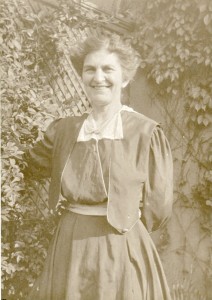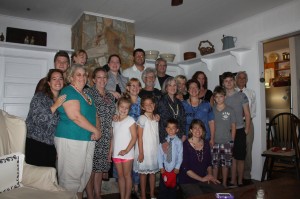
Louisa Hungerbuehler Ottens
From letter #16
November 27, 1917
Bible Institute of Los Angeles
A very long letter ends:
“And now, I’ve written all this to you, Mother dear because you are my Mother. I can still talk things out with you, only it comes in inky form.”
I think as we begin to delve into the letters and life of Helen, we need to pause and pay some attention to Louisa Ottens, the Mother, always with a capital M, to whom our letter-writer, twenty-one at the time of this letter, is so devoted.
We must know Louisa primarily through inference because we do not have her part of the letter exchange. Her letters are missing and we will not be able to hear her “voice.”
There is one person left, I know of, who will remember Louisa. That would be Helena Talmage’s sister, Betty Schlichter – Louisa’s second granddaughter. I hope to visit Aunt Betty this fall. She is ninety-two and very sharp. I think she will be helpful in “finding Louisa.”
We have some photos of Louisa, like the one above, in which she always looks pleasant, affable and hardy.
Helen frequently asks her Mother how her garden is doing – particularly inquiring after the chrysanthemums! She regularly describes the gardens of California to her – or the variety of blooms in a flower shop. They seem to share a love of flowers.
Louisa writes to her young daughter as frequently as she is written to – which is often. We have no way of knowing if her correspondence is as lengthy and detailed as her daughter’s. Helen requests things to be sent from home – vanilla, sugar and pretzels (always at the top of the list). She makes suggestions for Christmas gifts for her and Alfred! Helen graciously acknowledges each receipt – so we know her requests are fulfilled. Mother is attentive.
I have discerned a pattern in Helen’s letters (I’ve only read sixteen so far). Each has two distinct parts – a detailed, up-beat description of domestic life and goings on, and a rather serious and impassioned religious discourse. Sometimes the transition, or lack of it, from one to the other, is a bit jolting.
Helen is a newly-wed, enjoying Alfred’s company and dotting attention, learning to cook, sewing , shopping, decorating their home. She is also a devotee to a passionate, fundamentalist Christian movement, inspired by Billy Sunday ( more about him later). She and her husband are in Los Angles for two years of religious study before going off to be missionaries abroad.
So, Helen discusses theology and the religious context of her study and life with her Mother in each letter.
However, Loiusa does not participate in the religious conversation. I know this because it is commented on by Helen in a letter. Louisa ignores the topic but Helen continues to try to engage – to convert her family of “lukewarm Christians” to “know” Christ – not to just know “of'” Him. Maybe there will be a reply on this topic from Louisa somewhere down the road, in later letters. We’ll see.
An interesting tid-bit about Louisa, that I know from family interviews, is that she dated Henry Ottens of Philadelphia first, but married his brother, William Frederick Ottens, a candy maker. Henry ended up being a successful, wealthy businessman and would become a patron of Wildwood, New Jersey.
So, Louisa did not marry the wealthy brother. I have been told that everyone through the generations has wondered about her choice. My guess is she liked William better! The question would be “why?”
Louisa’s maiden name was Hungerbuehler; her parents were German immigrants. Her mother, “Grossmama,” is alive when the letters are being written. Helen asks about her often and occasionally writes to her grandmother at 1520 North Franklin Street in Philadelphia.
I will try to glean more from the letters about Helen’s Mother, Louisa, as I proceed.
What is it about her, or Helen, that has created such a demonstrative mother-daughter relationship? Perhaps this was not uncommon in the post Victorian era.
It would also be interesting to try to find out more about Louisa’s relationship with Helen’s younger sister, Mildred.
Helen and Mildred were like night and day.
There is a large, interesting extended family dynamic in Helen and Louisa’s life to also be explored. Louisa’s sister’s Amelia, Alberta, Alma, Flora, Laura and her brother, Conrad Hungerbuehler; wealthy Uncle Henry Ottens, Uncle Charles Beck and cousin Charles Beck (on the Ottens side), surround Louisa and Helen in a rich context in turn of the century Philadelphia.
Where to begin….

